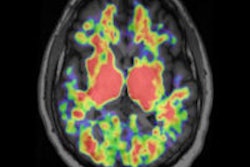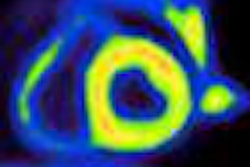PET using carbon-11-labeled Pittsburgh Compound B (C-11 PiB) shows promise for assessing beta-amyloid deposits in the brain and may have a potential role as a diagnostic aid for early Alzheimer's disease, according to research published online in the Archives of Neurology.
The study findings support the use of C-11 PiB-PET in evaluating beta-amyloid brain deposits -- for example, with mild cognitive impairment, Alzheimer's disease, or normal-pressure hydrocephalus (NPH), according to a Finnish research team led by Dr. Ville Leinonen, Ph.D., of Kuopio University Hospital.
The researchers sought to compare PET with C-11 PiB findings in patients with and without Alzheimer's disease lesions in frontal cortical biopsy specimens. Ten patients who had undergone intraventricular pressure monitoring with a frontal cortical biopsy for suspected normal-pressure hydrocephalus were included in the study (Arch Neurol, August 11, 2008).
After receiving an intravenous injection of C-11 PiB as a bolus, all patients underwent a 90-minute dynamic PET scan on an Advance PET scanner (GE Healthcare, Chalfont St. Giles, U.K.) in the 3D scanning mode. PET imaging was performed without knowledge of the patient's neuropathological data.
In patients with beta-amyloid aggregates in the frontal cortical biopsy specimen, the PET imaging revealed higher C-11 PiB uptake (p < 0.05) in the frontal, parietal, and lateral temporal cortices and in the striatum compared to patients without frontal beta-amyloid deposits.
"Our results indicate that [beta-amyloid] deposition in a frontal cortical biopsy specimen obtained during life is in line with the C-11 PiB uptake found in PET imaging, suggesting that C-11 PiB-PET reflects brain [beta-amyloid] deposition," the authors wrote.
The most significant differences in C-11 PiB uptake between patients with beta-amyloid immunoreactivity in the frontal cortical biopsy specimen and those without were seen in the frontal cortex (phase 1), the lateral temporal cortex (phase 2), the anterior and posterior cingulated gyri (phases 2-3), and the caudate nucleus (phase 3), according to the authors.
The researchers noted that the patients with the highest beta-amyloid in the biopsy specimen also had the highest C-11 PiB uptake on the PET images.
"The correlation and SPM [statistical parametric mapping] analysis showed that the C-11 PiB uptake increased with increasing [beta-amyloid] load in the biopsy specimen," the authors wrote. "Our findings are congruent with the previous PET data from patients with Alzheimer's disease or mild cognitive impairment and from healthy controls."
The authors noted that large prospective studies are required to verify whether C-11 PiB-PET will be a diagnostic aid, particularly in early Alzheimer's disease.
"Another potential use of C-11 PiB would be the quantitative monitoring of [beta-amyloid] deposits in the brain in subjects under treatment in pharmaceutical trials of early Alzheimer's disease targeting amyloid accumulation," the authors concluded.
By Erik L. Ridley
AuntMinnie.com staff writer
August 12, 2008
Related Reading
PET scans help spot and classify dementia types, March 27, 2008
FDG-PET CAD scheme boosts diagnostic accuracy for Alzheimer's, October 2, 2007
FDG-PET can influence Alzheimer's, dementia treatment, September 6, 2007
PET shows promise in atypical dementia evaluation, August 29, 2007
Studies link Alzheimer's to beta-amyloid and potential for new ligand, June 26, 2007
Copyright © 2008 AuntMinnie.com



















